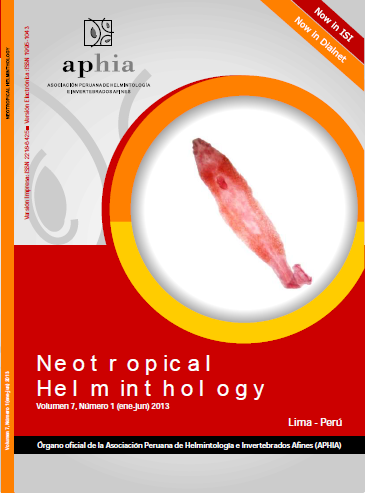ECOLOGICAL ASPECTS OF MONOGENEAN GILL PARASITES (PLATYHELMINTHES) FROM HOPLIAS AFF. MALABARICUS (BLOCH, 1794) (PISCES, ERYTHRINIDAE) IN A NEOTROPICAL FLOODPLAIN
DOI:
https://doi.org/10.24039/rnh201371953Keywords:
Aspiculuris tetraptera, Mexico, Mus musculus, Syphacia obvelata, vivaria mice.Abstract
We analyzed 54 specimens of Hoplias aff. malabaricus (Bloch, 1794) collected between March 2010 and March 2011 from the upper Paraná river Neotropical floodplain, Brazil. All hosts were parasitized by at least one species of Monogenea. The parasites species with higher prevalence were Urocleidoides cuiabai Rosim, Mendoza-Franco & Luque, 2011 (96.29 %) and U. malabaricusi Rosim, Mendoza-Franco & Luque, 2011 (92.59%). The community of gill ectoparasites examined showed an aggregated pattern. Urocleidoides cuiabai was the dominant species in the sample (C > 0.25). The parasitic abundance showed significant positive correlation with the standard length of the host for U. malabaricusi and U. eremitus Kritsky, Thatcher & Boeger, 1986. There were significant differences in the abundance values between male and female fish to the species of parasites Urocleidoides brasiliensis Rosim, Mendoza-Franco & Luque, 2011 and U. cuiabai. The gonad maturation stages of the host did not influence the levels of parasitism. Four species of parasites showed positive and significant correlation with parasitic abundance and the relative condition factor. The Ivinheima river presented higher abundance of parasitism in relation to other subsystems. The ecological study of monogeneans can provide a greater knowledge of the biology of these parasites and their hosts, the collection site, and even how the host responds to the presence of these parasites. We discuss the factors that were fundamental in the levels of parasitism in this important fish species in the floodplain of the upper Paraná river.
Downloads
Published
How to Cite
Issue
Section
License
Copyright (c) 2021 Neotropical Helminthology

This work is licensed under a Creative Commons Attribution-NonCommercial-NoDerivatives 4.0 International License.
OBJETO: El AUTOR-CEDENTE transfiere de manera TOTAL Y SIN LIMITACIÓN alguna al CESIONARIO los derechos patrimoniales que le corresponden sobre la (s) obra(s) tituladas: xxxxxxxxxxxxxxxx, por el tiempo que establezca la ley internacional. En virtud de lo anterior, se entiende que el CESIONARIO adquiere el derecho de reproducción en todas sus modalidades, incluso para inclusión audiovisual; el derecho de transformación o adaptación, comunicación pública, traducción, distribución y, en general, cualquier tipo de explotación que de las obras se pueda realizar por cualquier medio conocido o por conocer en el territorio nacional o internacional.
REMUNERACIÓN: La cesión de los derechos patrimoniales de autor que mediante este contrato se hace será a título gratuito.
CONDICIONES Y LEGITIMIDAD DE LOS DERECHOS: El AUTOR-CEDENTE garantiza que es propietario integral de los derechos de explotación de la(s) obra(s) y en consecuencia garantiza que puede contratar y transferir los derechos aquí cedidos sin ningún tipo de limitación por no tener ningún tipo de gravamen, limitación o disposición. En todo caso, responderá por cualquier reclamo que en materia de derecho de autor se pueda presentar, exonerando de cualquier responsabilidad al CESIONARIO.
LICENCIA DE ACCESO ABIERTO: El AUTOR-CEDENTE autoriza que manuscrito publicado en La Revista Neotropical Helminthology permanece disponible para su consulta pública en el sitio web https://www.neotropicalhelminthology.com/ y en los diferentes sistemas de indexación y bases de datos en las que la revista tiene visibilidad, bajo la licencia Creative Commons, en la modalidad Reconocimiento-No comercial- Sin Trabajos derivados –aprobada en Perú, y por lo tanto son de acceso abierto. De ahí que los autores dan, sin derecho a retribución económica, a la Asociación Peruana de Helmintología e Invertebrados Afines (APHIA), los derechos de autor para la edición y reproducción a través de diferentes medios de difusión.


 Numero 2 Volumen 19 - 2025 (versión Anticipada)
Numero 2 Volumen 19 - 2025 (versión Anticipada)














































